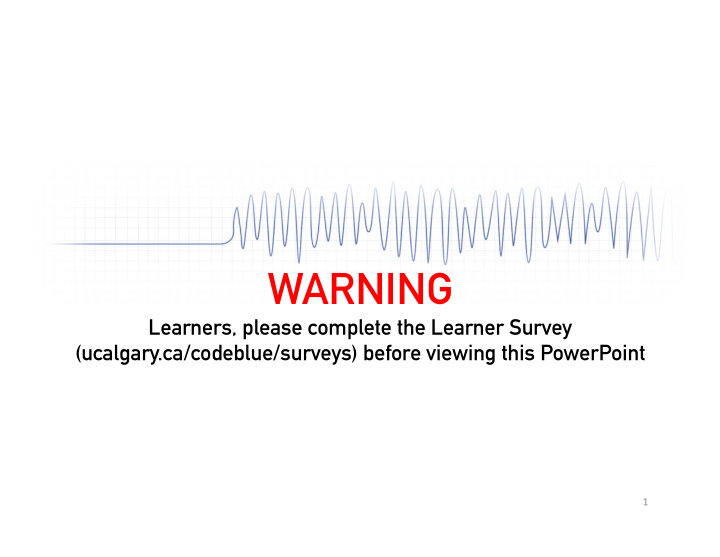



WARNING Learners, please complete the Learner Survey (ucalgary.ca/codeblue/surveys) before viewing this PowerPoint 1 ¡
INTRO TO CODE BLUE 2 ¡
INTRO TO CODE BLUE PURPOSE Experience management of code blues Suggest plans for acute care cases ¡ Practice leadership and teamwork skills ¡ Practice early CPR and defibrillation 3 ¡
INTRO TO CODE BLUE CASES Tension PTX | Pulseless VT ¡ ACS | VF ¡ Anaphylaxis | Asystole ¡ Upper GI Bleed | PEA ¡ 4 ¡
INTRO TO CODE BLUE LOGISTICS SIM ¡ Debrief ¡ TEAM LEADER (MD) ¡ MEDS/ CPR AIRWAY DEFIB (RN) ¡ (RT) ¡ (RN) ¡ RECORDER (RN) ¡ 5 ¡
INTRO TO CODE BLUE OSCE FORMAT Y SURVEY ¡ PRIMARY Assessment ¡ Action ¡ ABCs ¡ Help, O2, IV, Monitor ¡ Y SURVEY ¡ SECONDARY Assessment ¡ Action ¡ History, Vitals, Exam ¡ Targeted Treatment ¡ BLUE ¡ CODE CODE BLUE Assessment ¡ Action ¡ Rhythm, Pulse ¡ CPR/Defib, Epi, Hs&Ts, Team ¡
INTRO TO CODE BLUE PRIMARY SURVEY Primar ary Survey ey Assessm ssessmen ent Action on Exam xampl ples es Exam xampl ples es Immediately Airway: patency, Call for help life-threatening secretions, obstruction O2 Breathing: RR, O2 Sat, work of breathing, lung Needle decompression sounds, tracheal deviation IV Circulation: HR, BP, Monitor LOC, bleeding, temperature Fluids 7 ¡
INTRO TO CODE BLUE SECONDARY SURVEY Sec econ ondar dary Survey ey Assessm ssessmen ent Action on Systematic survey History (SAMPLE) Investigations Signs and symptoms Allergies Differential diagnoses Medications PMHx Treatments Last oral intake Events prior Vitals Head-to-toe Exam 8 ¡
INTRO TO CODE BLUE ARREST RHYTHMS VF Only 2 “shockable” (defib) arrest rhythms Pulseless VT Asystole Other arrest rhythms, including asystole and PEA, Everything else with NO pulse is PEA should NOT be defib PEA (Pulseless Electrical Activity) 9 ¡
INTRO TO CODE BLUE CODE BLUE ALGORITHMS Pulseless VT, VF SHOCK EPI SHOCK 2min CPR 2min CPR Rhythm/Pulse Rhythm/Pulse Asystole, PEA Nothing EPI Nothing 2min CPR 2min CPR Rhythm/Pulse Rhythm/Pulse Shockable (Pulseless VT, VF): try 2 shocks before EPI Non-shockable (Asystole, PEA): may give EPI early 1:10,000 EPI 1mg IV q4 min 10 ¡
INTRO TO CODE BLUE CODE BLUE EXAMPLE No response, not breathing Rhythm Rhythm Pulse se Assessm ssessmen ent Action on VT None Pulseless VT arrest Start CPR 200J shock/defib 2 minutes of CPR VF None VF arrest Resume CPR 200J shock/defib 1mg epi 1:10,000 IV 2 minutes of CPR Asystole None Asystole Resume CPR No shock/defib 2 minutes of CPR Bradycardia None PEA Resume CPR No shock/defib 1mg epi 1:10,000 IV 2 minutes of CPR 11 ¡
INTRO TO CODE BLUE EARLY CPR, EARLY DEFIBRILLATION 12 ¡
INTRO TO CODE BLUE Hs AND Ts Hypovolemia Tension PTX Hypoxia Tamponade Hydrogen ion Toxins Hyper/hypokalemia Thrombosis (pulmonary) Hypothermia Thrombosis (coronary) 13 ¡
INTRO TO CODE BLUE Narrow VS Wide Complex PEA 14 ¡
INTRO TO CODE BLUE ACUTE CORONARY SYNDROME (ACS) O2 ASA Nitroglycerin Ticagrelor or Clopidogrel Morphine Thrombolytic UFH or LMWH PCI β B CABG ACEi/ARB Statin Lifestyle changes RISK REDUCTI TION 15 ¡
INTRO TO CODE BLUE ANAPHYLAXIS 57% unrecognized or not labeled in ED Multisystem syndrome Distributive shock (widespread vasodilation) Hypovolemic shock (fluid extravasation, reduced venous return) 16 ¡
INTRO TO CODE BLUE ANAPHYLAXIS SYMPTOMS Derm (80-90%): flushing, itching, urticaria, angioedema Resp (70%): nasal sx, throat sx, cough, wheeze, SOB GI (45%): N/V/D, abd pain, dysphagia CVS (45%): faint, tachycardia, hypotension, collapse CNS (15%): dizziness, headache, LOC Other: metallic taste in mouth 17 ¡
INTRO TO CODE BLUE ANAPHYLAXIS DX Exposure to allergen & either: sBP 2+ Adults <90 Decrease 30% Do o NOT T need eed to o kn know ow al aller ergen gen if: - Der erm/R /Resp esp - Der erm/C /CVS 18 ¡
INTRO TO CODE BLUE ANAPHYLAXIS TX 1 st st L LINE INE = E = EPINE PINEPHRINE PHRINE ADJU JUNCTS TS 1:1000 epinephrine IM Shock/CVS: fluids anterolateral thigh Resp: oxygen, salbutamol Derm: H1 and H2 blocker Adults: 0.3 mg β B: glucagon Peds: 0.15 mg PREVENTI TION OF 2 nd nd LONG-TE TERM Steroids may prevent Epinephrine injector biphasic or protracted Wear/carry allergy anaphylaxis identification 19 ¡
INTRO TO CODE BLUE EPINEPHRINE IS FIRST LINE α 1 Vasoconstriction Increased peripheral vascular resistance Decreased mucosal edema and membrane leakage β 1 Increased inotropy (contractility) Increased choronotropy (heart rate) β 2 Bronchodilation Decreased mast cell and basophil mediator release 20 ¡
INTRO TO CODE BLUE TENSION PNEUMOTHORAX Needle decompression: 14G needle 2 nd ICS mid-clavicular line Alternate site: 5 th ICS just anterior to mid-axillary line 21 ¡
INTRO TO CODE BLUE TENSION PNEUMOTHORAX Chest tube: 5 th ICS just anterior to mid-axillary line 22 ¡
INTRO TO CODE BLUE Acute Upper GI Bleed Early Manage Intubation Fluids, O negative blood Crossmatch (note: 1 unit = 10 Hb) Consider if: Transfuse blood (if Hb < 70) 1. Ongoing hematemesis 2. Altered respiratory status Consults 3. Altered mental status Meds Consider: 1. GI Antibiotics for cirrhotic pts. 2. ICU Consider PPI (ulcers) and 3. General Surgery octreotide (varices), but may 4. Interventional Radiology not decrease mortality rate. 23 ¡
INTRO TO CODE BLUE ACLS EFFECTIVE TEAM DYNAMICS Closed-loop communication* Clear messages* Clear roles and responsibilities* Knowing one’s limitations Knowledge sharing Constructive intervention Re-evaluation and summarizing* Mutual respect 24 ¡
Slides by: Anthony Seto Cardiac Arrest Content Reviewer: Natalia Jaworska ACS Content Reviewer: Patricia Lee Anaphylaxis Content Reviewer: Kia Rokui Tension PTX Content Reviewer: Ryan Wilke UGIB Content Reviewer: Christina Yang, Niky Antony
26 ¡
27 ¡
Recommend
More recommend